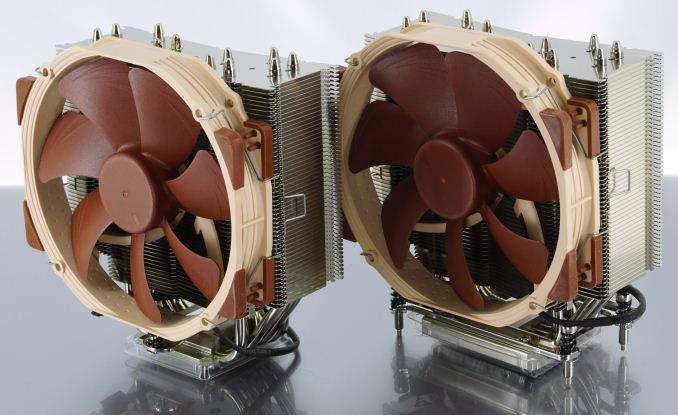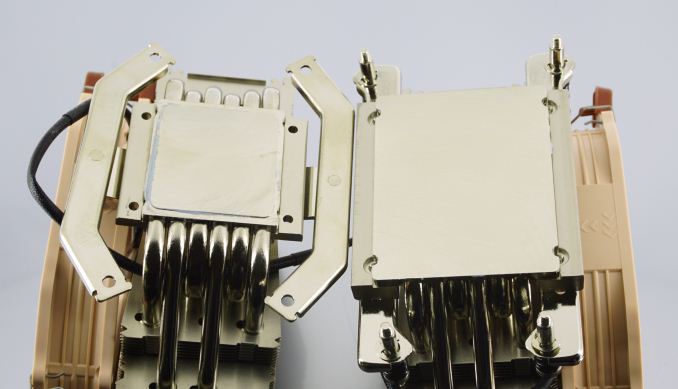Analyzing Threadripper Thermals: Big Base Cooling Wins
by E. Fylladitakis on March 14, 2018 8:30 AM EST- Posted in
- CPUs
- AMD
- Cases/Cooling/PSUs
- Noctua
- ThreadRipper
- 1950X
- CPU cooler
Conclusion
AMD’s Threadripper processors certainly do not require liquid coolers to function properly at stock, even if the manufacturer recommends them. It may be that AMD had to recommend them because older cooler designs were designed for processors much smaller in size than the Threadripper and are incapable of providing adequate heat energy transfer rates, as their base does not make full contact with the processor’s lid. AMD probably foresaw that many companies will rush to offer adapters or modify their current designs to fit TR4 processors, even though their surface area was much greater than their AM4 counterparts. A partial surface contact greatly increases the thermal resistance of the whole setup, so very low resistance coolers were required to compensate for this. However, when a good air cooler is specifically designed for the TR4 socket, it can easily cope with the thermal requirements of the AMD Threadripper 1950X.
Noctua is one of the few cooler manufacturers that straightforwardly advise against the mounting of their older design on SP3/TR4 processors. As other manufacturers were openhandedly supplying adapters, this choice earned them a bit of distrust, as a few assumed that Noctua wanted to force their customers into buying new coolers. However, our findings today justify their choice and prove that Noctua did the right thing, regardless of any short-term consequences it may have had on the company's reputation.
Will using adapters on earlier cooler designs work? Yes, but their performance will be far from optimal and, depending on the size of the cooler’s surface area, they can also be dangerous for heavy load applications. High end air coolers and liquid coolers will be able to cope with the needs of the TR4 processor, but they will run hotter, or louder, or both, than their equal derivatives that were redesigned to properly cover a TR4 processor.
If you are upgrading from another platform/socket and are wondering whether to buy adapters for your cooler, our generic suggestion is “don't”. Even if you have one of the best air coolers, the performance impact is so large that even a significantly less expensive TR4-specific cooler is likely to perform better. Instead of spending time and money on adapters, just buy an appropriate cooler specifically designed for TR4 processors. When building a >$1.500 system, an extra $50 for an appropriate cooler can be easily justified. If you have a custom liquid cooling setup, just get another CPU block, one specifically designed for TR4 processors. The use of adapters makes sense only as a relatively short-term "bandaid" solution, for emergency cases and special situations only.












43 Comments
View All Comments
Ryan Smith - Wednesday, March 14, 2018 - link
To clarify, the title of page 2 is a bit of humor. E. isn't a doctor (though Ian is).LordanSS - Wednesday, March 14, 2018 - link
Thank you for the article. It was a good read with the thermodynamics explanation as well.fackamato - Wednesday, March 14, 2018 - link
What are the decibels during load for each cooler/rpm?Valantar - Wednesday, March 14, 2018 - link
A fascinating read. Now for the follow-up: an article where you test sticking two 212 Evos side by side on a Threadripper. That should cover most of the IHS, no?LanceLLandon - Wednesday, March 14, 2018 - link
My preference is Peltier air cooling. By cooling a processor slightly frozen less thermal noise is generated and less miscalculations are performed. Perhaps this is more important for studio Sound Recording and Mixing/Editing or Movie Video Editing or for Work Station performance. If I am going to all the trouble to build a multi core computer I will also so go to the trouble of cooling it far more effectively.MrSpadge - Wednesday, March 14, 2018 - link
A Peltier cooler will help you with extreme OC, if sized properly, but apart from that will only increase your energy consumption significantly. If you want lower temperatures go for chilled water, that's far more efficient. But you absolutely don't need that. Otherwise all the servers in data centers, DELL shops etc. would have to be constructed differently. And if you really want to reduce the chance of calculation errors beyond the manufacturer specification, simply drop the CPU clock by 100 MHz.BTW: are you using ECC RAM? Not that I'm recommending it for home computers, but if not you're definitely overshooting with that Peltier and should care for more probable points of failure first.
Crazyeyeskillah - Wednesday, March 14, 2018 - link
Water or GTFO.master381 - Wednesday, March 14, 2018 - link
Nice article!A question - on Page 3, is this supposed to read " absolute thermal resistance of the cooler itself needs to be very *low,*" instead of high?
Excerpt:
"The high thermal resistance caused by an undersized contact plate cannot be easily countered, which is why the absolute thermal resistance of the cooler itself needs to be very high, i.e. why AMD’s cooler recommendations are so over the top."
Ryan Smith - Thursday, March 15, 2018 - link
That was meant to read "thermal conductance". Thanks!zodiacfml - Wednesday, March 14, 2018 - link
The conclusion I can get from here is that desktop CPU with around 90W TDP can also benefit from the larger surface area, considering the differences in temps at idle of the TR chip.